Abstract
A diode-based rectifier (DR) is an attractive transmission technology for offshore wind farms, which reduces the volume of large bulk platforms. A novel parallel–series DC wind farm based on a distributed DR is proposed, which meets the requirements of high voltage and high power with an isolation capability from other units. The coupling mechanism between a modular multilevel converter (MMC) and a DR has been built, and the coordinate control strategy for the whole system has been proposed based on the MMC triple control targets with intermediate variables. Under the proposed control strategy, the system automatically operates at maximum power point tracking (MPPT). The feasibility of topology and the effectiveness of the control strategy are verified under start-up, power fluctuation, onshore alternating current (AC) fault, and direct current (DC) fault based on the power systems computer-aided design (PSCAD)/electromagnetic transients including direct current (EMTDC) simulation.
1. Introduction
Total global offshore wind capacity is expected to increase to 84 GW by 2024, and 494 GW of offshore wind will be installed by 2030 to achieve the carbon neutrality target [1,2]. Offshore wind farms are moving toward the deep sea, which is located at a distance far beyond 100 km. Offshore wind farm ratings have become larger than 1000 MW, and at least 10 voltage source converter high voltage direct current (VSC-HVDC) projects have been built or are planned for deep-sea offshore wind power integration in Germany and China. However, the volume of large-capacity offshore platforms is large, and the investment cost is high, nearly USD 3 billion. To overcome these difficulties, a diode rectifier-based HVDC topology is proposed, of which investment can be 30% of the VSC-HVDC, which represents a more economical solution for long-distance offshore wind farms [3,4].
The diode rectifier (DR)-HVDC is composed of grid-forming wind turbines, a diode-based rectifier, and an onshore converter. Prior literature details solutions for the wind turbine control strategy and start-up issues [5,6,7,8,9]. However, it is difficult to realize coordinated control among hundreds of wind turbines. According to the mechanism for the grid-forming control strategy, large reactive power is needed to maintain the frequency of the offshore wind farm, which may influence the active power of the wind turbines. Synchronization issues exist if the cables are long.
Several methods exist to build direct current (DC) transmission voltage, including the series-parallel topology, series topology, and parallel topology. An offshore wind power medium-voltage direct-current transmission system based on paralleled DR is proposed in [10] to solve the issues. The parallel ones reduce the offshore platforms, and it is suitable for a small-scale wind farm as the cable current is limited. A series-connected distributed DR is proposed for a higher voltage transmission system in [11,12], while the alternating current (AC) collection lines still exist. The series-connected topology can transmit larger power but shows less reliability. Once one cable is broken, the whole string will be out. An enhanced series-connected system with fault-resilient capability was proposed previously [13], in which a grouping scheme or extra auxiliary cables will be added. In addition, the top wind turbine unit in the series string will withstand a high DC voltage, thus meeting the insulation challenge and limiting the transmission voltage level.
Considering the reliability and insulation, the parallel topology is more suitable for an offshore wind farm. To improve the transmission capacity, an offshore station with a DC/DC converter is needed to increase the voltage level. Several DC/DC converter topologies have been proposed [14,15]. Refs. [16,17,18,19,20] propose a DC/DC converter based on a modular multilevel converter (MMC) with galvanic isolation. Refs. [21,22] propose a non-isolated high-power DC/DC converter with a lower current stress on the medium voltage (MV) side and lower voltage stress for the high voltage (HV) side. Compared with traditional voltage source converter (VSC) platforms, the DC/DC platforms are smaller and reduce the voltage stress of wind turbines, making the parallel scheme more attractive. A higher transformation ratio with a smaller volume is more urgent. The fault isolation and multilevel coordinate control strategy should be analyzed further.
This paper aimed to propose a wind farm topology based on parallel–series distributed DRs with higher reliability and a higher transformation ratio. Firstly, the requirements for topology are pointed out, a parallel–series structure with DC fault isolation capability is proposed, and its balancing mechanism is presented in Section 2. Secondly, the mathematical model of DR is built, and a control strategy for converters is proposed to achieve the decoupling control strategy for parallel and series strings in Section 3. Under the proposed control strategy, the wind turbines automatically operate at maximum power point tracking (MPPT) without overvoltage and overcurrent. In addition, the energy accumulating mechanism among different DC voltage levels is analyzed, and an active voltage injection control strategy is proposed for onshore AC faults. Finally, a 1000 MW case of a wind system based on parallel–series distributed DR is built in PSCAD/EMTDC in Section 4. The conclusions are presented in Section 5.
2. System Structure and Coupling Mechanisms
2.1. The Parallel–Series DC Wind Farm
The system should satisfy the following requirements:
- (1)
- The wind turbines can track the maximum power point at the steady state without overcurrent and overvoltage.
- (2)
- The different strings should not be disturbed from each other during a fault or power fluctuations.
- (3)
- The system can achieve fault ride-through of onshore and offshore faults.
- (4)
- Galvanic separation should be provided for wind generators and DC/DC converters.
- (5)
- The system can be started up.
Figure 1 shows the proposed parallel–series DR system. The MV side DR (MVDR) is connected in parallel at the common MV DC link. The HV side DR (HVDR) is connected in series.
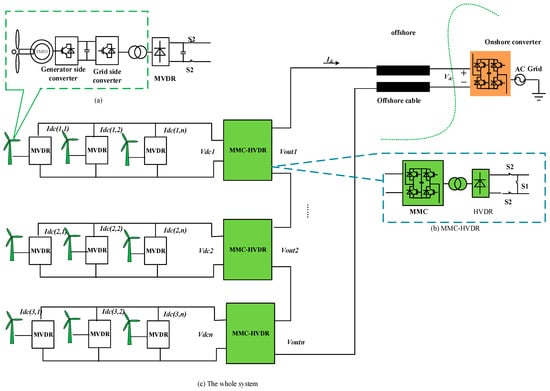
Figure 1.
The topology of a parallel–series DR system. (a) The topology of wind turbine and MVDR; (b) The topology of MMC-HVDR; (c) The whole system topology.
The whole system includes the wind turbine, MVDR, MMC-HVDR, offshore cable, and onshore converter.
- (1)
- The wind turbines in offshore wind farms are normally composed of a permanent magnet synchronous generator (PMSG), as shown in Figure 1a. The transformer in a wind turbine achieves galvanic separation between the generators and MVDC.
- (2)
- MVDR is installed in the wind turbine as a distributed system. Several MVDRs are connected in parallel. The output current is Idc(i,j), and the output voltage is Vdci. The start-up problem caused by the DR can be solved by installing a small energy storage system in the wind turbines. S2 is a bypass breaker and will be open if one unit of MVDR is broken, and the other units will not be disturbed.
- (3)
- The MMC-HVDR is composed of the MMC converter, HVDR converter, and transformer, as shown in Figure 1b. It collects the power from the parallel-connected MVDR and boosts the MVDC voltage Vdcj to a higher DC voltage Voutj. Then, HVDR is connected in series to match the transmission voltage of Vdc. The transformer achieves galvanic separation and makes it easier to gain a high transmission ratio. A bypass breaker, S1 and S2, can be used for the unit outage. S1 is closed and S2 is open if one of the MMC-HVDR units is broken, while another unit can keep operating without being disturbed.
- (4)
- The offshore cable transmits the power from HVDR to the onshore converter. The current in the HVDC link is Idc.
- (5)
- MMC with zero DC side voltage operation capability, such as the full bridge submodule (FB SM) or hybrid topology, is used as the onshore converter station to achieve DC fault ride-through.
2.2. Coupling Mechanism
The control strategy of a parallel–series system is crucial to maintaining the stability of the system during steady-state operation and fault periods. The coupling mechanism for series and parallel connections is analyzed separately.
In the series-connected part, that is the HVDR, if the network operates under a constant DC voltage (CDV) mode, the sum DC voltage of HVDR in the string is Vdc, which is determined by the onshore converter and is a fixed value. The output voltage is shown as follows:
The nominal output voltage of DR Vout_N is obtained by dividing Vdc by N. The average output power Pavg is obtained by dividing the sum of the output power of all wind turbine generators in the branch by the number of wind turbines n.
When a power imbalance occurs, the unit’s output voltage with the higher power will exceed its rated value. In addition, once a HVDR unit is out of operation, its power command is 0, and the remaining units will operate in an overvoltage state even if their power remains balanced. However, considering system safety and insulation voltage costs, the output voltage of the HVDR should be limited. The output voltage curves for two units are shown in Figure 2a.
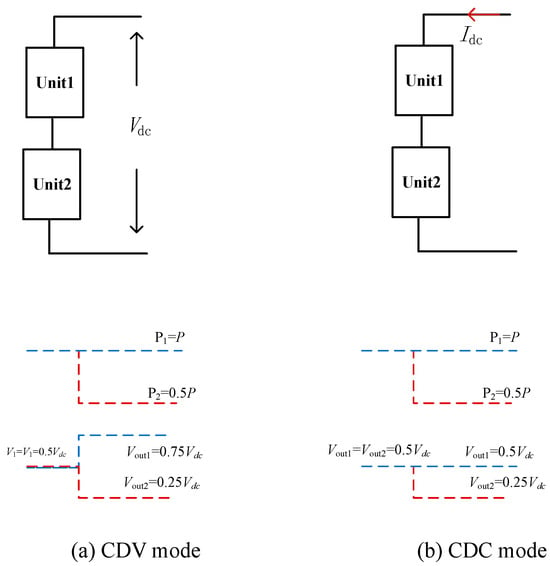
Figure 2.
A comparison of the CDV and CDC modes.
If the network operates under a constant DC current (CDC) mode, the current flow through the string is equal. Each HVDR’s output voltage will vary with its output power, which decouples the unit’s output voltage coupling and will not be disturbed by the adjacent HVDRs. The output voltage curves are shown in Figure 2b.
In the parallel-connected part, that is the MVDR, if the network operates under the CDV mode, each unit’s output current will vary with active power.
If the parallel-connected MVDR operates under the CDC mode, the output voltage of each unit will vary with output power. When the MVDR output powers are different from each other, the output current with the higher power will exceed its rated current value.
According to the analysis above, the CDC control mode is recommended for a series-connected topology, and the CDV control mode is recommended for a parallel-connected topology.
The MMC can work in the current control mode, CDC, or voltage control mode, CDV. With MMC’s higher freedom of control capability, the coordinate control strategy for parallel–series topology is possible.
3. Coordinate Control Strategy of Distributed Parallel–Series DR Wind Farm
3.1. Mathematical Model of DR
For DR, an intermediate variable, Vo, was previously introduced [13], and the relationship between input and output is as follows:
where Vdc0 is the input voltage in the converter, m is the modulation index, Rdc is the resistor in the DC cable, and a, b, and c are indices related to the equipment parameters.
As the output power is as follows:
Only when , can the active power can be transmitted to the DC side, according to Equation (6).
Equation (7) shows that the slope, which is small, and the power output can be seen as proportional to Vo.
3.2. Control Strategy of Wind Turbines
According to Equation (7), a PI controller is used in the grid-side converter to achieve the active power control and AC voltage control. With the constant DC voltage, once the active power reference increases to ensure the output active power. The control strategy for the grid-side converter in wind turbines is shown in Equation (8) below.
where KpV, KiV, Kp, and Ki are the PI; the Vo increases controller coefficients.
Figure 3a shows the control block diagram. The grid-side converter controls the active power according to the MPPT.
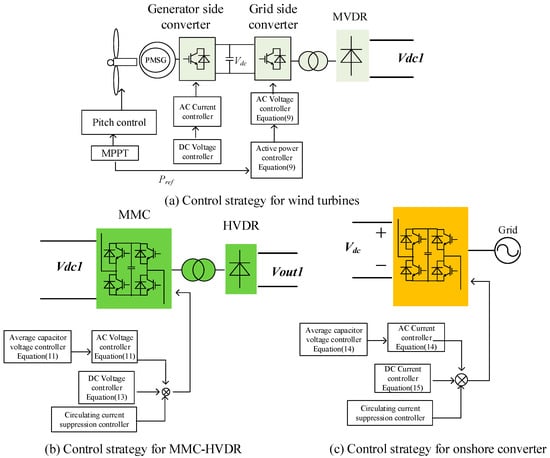
Figure 3.
The control block of the whole system.
3.3. Control Strategy of MMC-HVDR
According to the coupling mechanism in Section 2, the MMC should maintain the DC voltage on the MV side. The MMC should also maintain the DC voltage in the HV side by indirectly controlling the AC voltage of the MF transformer according to Section 3.1.
For the MMC, the arm voltage vap and van of phase A include three components that operate the DC component vdc, the fundamental frequency fluctuation component ua, and the second harmonic fluctuation component uacm:
According to Equation (9), the MMC has three degrees of freedom, which can be used to achieve DC voltage control and AC voltage control simultaneously.
The charging and discharging processes accompany the change in the submodules’ voltage during power fluctuation. The capacitor voltage of submodules can be chosen as the indicator for the energy balance of the MMC. According to Equation (7), the AC voltage of transformer VT will increase if the injected active power increases, and VT will decrease if the injected active power decreases. An average capacitor voltage–AC voltage controller can be used to keep the energy balance. With the average capacitor voltage control, the MMC and HVDR converter will automatically transmit the active power from wind turbines to the HVDC link.
The dynamic equation for the DC voltage can be expressed as [23]:
with the changes in DC port voltage, the capacitor voltage can also be controlled.
where Kpc, Kic are the PI controller coefficient. The control block is shown in Figure 3b. Once the capacitor voltage exceeds its limit, the DC voltage will increase and block the output of the MVDR.
3.4. Control Strategy of Onshore Converter
The currents flowing in the upper and lower arms of phase A are iap and ian.
According to Equation (11), the capacitor voltage and AC current can be controlled.
According to Equation (14), adjusting the DC voltage can achieve DC current idc control, that is:
Figure 3 presents the overall control strategy for the system. The generator side rectifier in the wind turbine controls both the DC voltage and AC current in the generator, ensuring they remain at the target values and preserving energy balance. The grid-side converter is responsible for implementing MPPT control and optimizing the power output. Meanwhile, the average capacitor voltage controller in the MMC captures the full wind power and transfers it to the onshore converter, which regulates the DC current in the DC cable.
According to Figure 3a, the transfer function is built for stability analysis, as shown in Figure 4. Moreover, the response under different control parameters is shown in Figure 5; it can be seen that with a larger Kp and Ki, the system will respond faster.

Figure 4.
The transfer function of the control strategy in wind turbines.
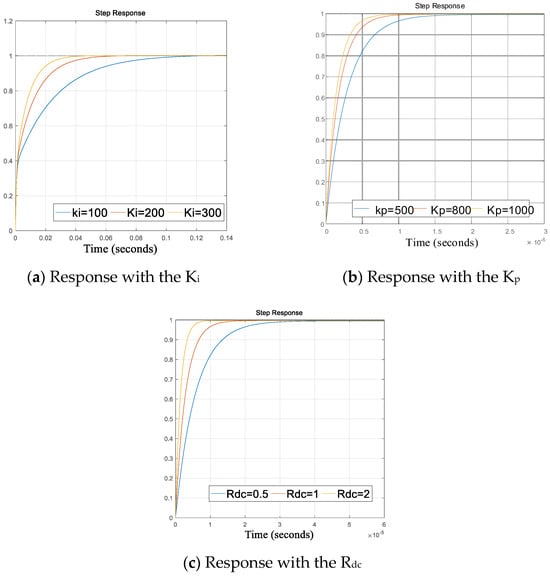
Figure 5.
The response with the control parameter.
If the DC cable is longer, the system will respond faster as it is a proportional parameter.
3.5. Active Voltage Injection Control for Onshore AC Fault
The active power from wind turbines flowing to the onshore converter can be seen as a waterfall, and the onshore converter can be seen as a large water pool with a drainage outlet. If an AC grounding fault occurs at the grid, the drainage outlet is blocked. The onshore converter operates in the DC current mode, meaning that the water still flows from offshore, and the energy keeps accumulating, as shown in Figure 6. The capacitor voltage will increase until the protection of the onshore converter is triggered, and the converter is blocked. However, the DC voltage will remain unchanged in the first stage of the fault.
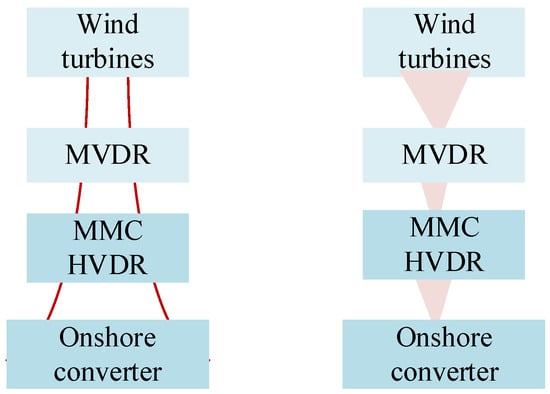
Figure 6.
The mechanism in the fault ride-through control strategy.
If the DC current in the onshore converter is reduced during an onshore fault, the power flow from the MMC-HVDR will be blocked. The capacitor voltage in the MMC-HVDR will rise, increasing the DC voltage in the DC collection network. Then, the active power controller in the grid-side converter will saturate, no more active power will be transmitted, and the whole system will stop automatically.
However, the above speed of the blocking process will be affected by the control parameters. To speed up the blocking process, an active injection control strategy is proposed for the MMC-HVDR, as shown in Equation (16). Once the capacitor voltage exceeds its upper limit, such as 1.1 p.u., the active injection control strategy will operate. As the VT is smaller than the Vout, the active power transmission will be blocked. The active injection control strategy can also be applied directly to the wind turbines by detecting the braking resistor state.
4. Simulation
A 1000 MW-rated parallel–series system was modeled in the PSCAD/EMTDC to evaluate its performance. The DC link rated current was 1.6 kA, and the DC voltage was ±320 kV. Each branch consisted of ten parallel-connected DRs, forming a 120 kV MVDC grid. The maximum power output of the parallel-connected string was 250 MW. An average model based on the FB-MMC from [23] was employed, and the HVDC transmission cable was represented by an equivalent resistance. The relevant parameters are provided in Table 1. The topology for simulation is shown in Figure 1.

Table 1.
Parameters of the system.
4.1. Start-Up
Firstly, at t = 0 s, the onshore MMC starts charging the submodule capacitors and establishes a DC link current. At t = 0.05, the DC current reaches 1.5 kA, as shown in Figure 7b, and the DC voltage is nearly 0, as shown in Figure 7a. Then, at t = 0.2 s, the first wind turbine string starts up, as shown in Figure 8. The wind turbine gradually outputs active power P1, charging the DC capacitor in the MVDR, the submodule capacitor in the MMC, and the DC output port capacitor in the HVDR to establish the DC voltage vout1 and vdc1 in the parallel wind farm string. At t = 0.8 s, the active power of the wind farm string is 100 MW, the DC voltage of MVDR reaches its rated value of 160 kV, the submodule capacitor voltage of MMC vc1 reaches 2.5 kV, and the HVDR output voltage is 100 kV. As the active power output of the wind turbine increases, according to Equation (6), with the increase of active power, at t = 2 s, the active power of the wind turbine reaches its maximum value of 250 MW, and the DC voltage of HVDR reaches its rated value of 160 kV. The first string of wind turbines has started and is being completed. Subsequently, the other strings are started in sequence, as shown in Figure 9. At t = 3 s, the second string of wind turbines starts at t = 4.5 s. The third string of wind turbines starts at t = 6 s and completes the start-up at t = 7.5 s. The fourth string of wind turbines starts at t = 9 s and completes the start-up at t = 10.5 s. Figure 9 shows no fluctuation in the capacitor voltage in the MMC submodule during the start-up process. It can be concluded that the parallel–series topology is decoupled from other branches during start-up. As shown in Figure 10a, as the wind turbine series gradually starts, the DC voltage in the HVDC line gradually increases to 640 kV. The DC current in the HVDC line does not change during the start-up process, as shown in Figure 10b.

Figure 7.
The waveforms for the HVDC link. (a) The DC voltage of HVDC link; (b) The DC current of HVDC link.
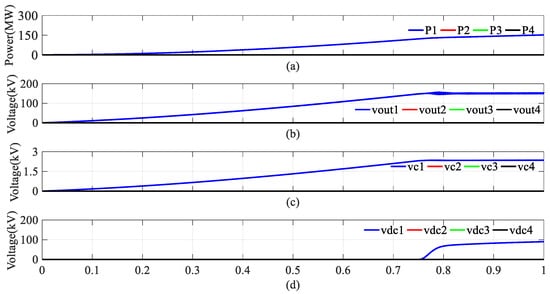
Figure 8.
The waveforms for the wind strings. (a) Active power of wind turbine; (b) Output voltage of MVDR; (c) Average capacitor voltage of MMC; (d) Output voltage of HVDR.
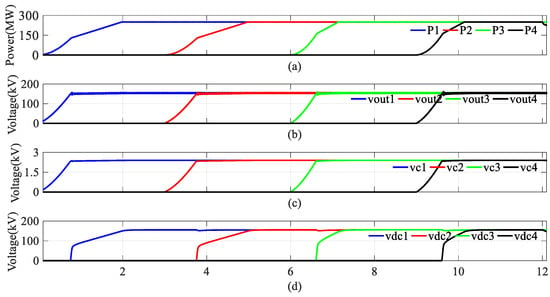
Figure 9.
The waveforms for offshore wind strings. (a) Active power of wind turbine; (b) Output voltage of MVDR; (c) Average capacitor voltage of MMC; (d) Output voltage of HVDR.

Figure 10.
The waveforms for HVDC links. (a) The DC voltage of HVDC link; (b) The DC current of HVDC link.
4.2. Power Fluctuation
At t = 12 s, the fourth string experienced active power fluctuations, whose output drops from 250 MW to 100 MW. The system then recovered to 250 MW at t = 14.7 s, while the active power from the other wind power strings remained stable, as shown in Figure 11a. During the fluctuation, the DC voltages vout1, vout2, vout3, and vout4 in the MVDR remained unchanged, as shown in Figure 11b. The capacitor voltage in the MMC-HVDR stayed constant, as shown in Figure 11c. These data mean the control strategy shown in Figure 2b is effective. The output DC voltage vdc4 in the HVDR initially decreased, gradually recovered, and increased back to its original level according to the power fluctuation, as shown in Figure 11d. These alterations are caused by the linearity exhibited in Equation (7). Meanwhile, the voltages in the other ports, Vdc1, Vdc2, and Vdc3, remained the same. The DC voltage in the HVDC line first decreased and then increased, with the DC current remaining constant, as shown in Figure 12. It can be concluded that the parallel–series topology is decoupled from other branches during power fluctuation.
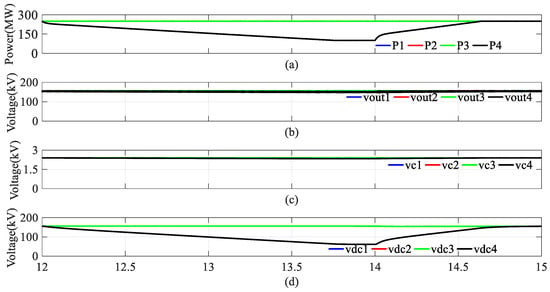
Figure 11.
The waveforms for wind turbines. (a) Active power of wind turbine; (b) Output voltage of MVDR; (c) Average capacitor voltage of MMC; (d) Output voltage of HVDR.

Figure 12.
The waveforms for the HVDC link. (a) The DC voltage of HVDC link; (b) The DC current of HVDC link.
4.3. DC Fault of Strings
At t = 1.5 s, a DC fault occurred at the fourth parallelled branch. The simulation results are shown in Figure 9 and Figure 10. Once the DC fault occurred, the line DC current in the fourth line increased. The DC fault current can be limited by blocking the submodule or reducing the DC voltage. This section mainly focuses on whether other branches are affected if a DC fault occurs in one branch, and the DC fault clearing will not be elaborated on here.
When a DC fault occurs, the DC voltage in the MMC, Vout4, decreases to 0, as shown in Figure 13b. Due to the coupling effects in the DR in Section 3.1, the power generated by the wind turbines gradually decreases to 0, as indicated in Figure 13a. As the MV side DC current rises during the DC fault, the submodule in the MMC will be quickly blocked, and the capacitor voltage in the MMC-HVDR in the faulty branch remains almost unchanged, as seen in Figure 13c. Once the MMC-HVDR stops the active power transmission, its output voltage Vdc4 drops to 0, as shown in Figure 13d. The voltage and current in the HVDC link are shown in Figure 14. The fluctuation in the DC current was minimal, while the DC voltage in the HVDC link decreased to 480 kV as the power diminished. The results presented in Figure 9 and Figure 10 highlight that the proposed topology has the capability of DC fault isolation. It can be concluded that the parallel–series topology is decoupled from other branches during a DC fault.
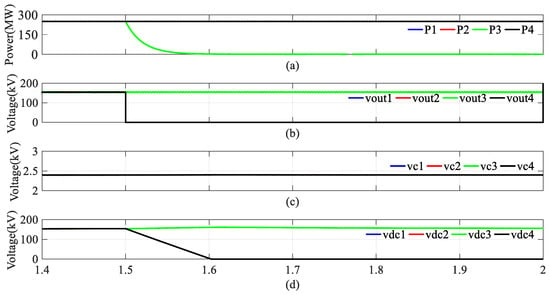
Figure 13.
The waveforms for wind turbines and MMC-HVDR converters. (a) Active power of wind turbine; (b) Output voltage of MVDR; (c) Average capacitor voltage of MMC; (d) Output voltage of HVDR.
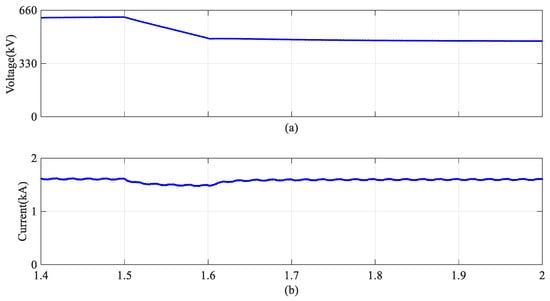
Figure 14.
The waveforms for the HVDC link. (a) The DC voltage of HVDC link; (b) The DC current of HVDC link.
4.4. Onshore AC Fault
At t = 3 s, a three-phase AC grounding fault occurred on the onshore AC grid, causing the AC voltage to drop to zero, as shown in Figure 15a. An overcurrent can be observed during an AC fault, as shown in Figure 15b. Consequently, the active power generated by the wind turbines could no longer be transmitted to the grid and accumulated at the converters. Due to the constant DC current control employed by the onshore converter, the DC current in the HVDC link remained stable during the first phase of the AC fault, assuming no additional control strategies were applied. The active power from the wind turbines continuously feeds into the onshore converter, leading to a steady increase in the capacitor voltage of the submodule, as seen in Figure 16c. The onshore converter is composed of the FB submodule, and under the modulation effect, the DC voltage in the HVDC link remains unchanged in the early phase of the fault, while the submodule capacitor voltage continues to rise. As a result, neither the MMC-HVDR nor the MVDR can detect the fault, and the active voltage limiting feature in the DR is not triggered. Without an additional control strategy, the vout1, Vdc1, and Vc1 values remain constant, as shown by the pink curve in Figure 16.
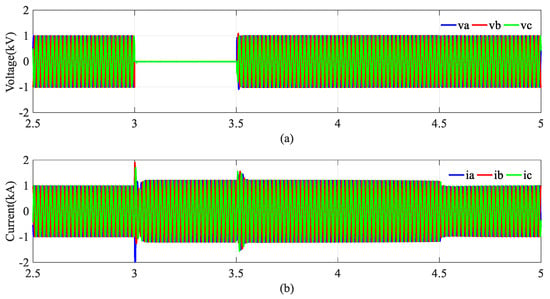
Figure 15.
The waveforms of onshore AC voltage and current. (a) AC voltage (b) AC current.
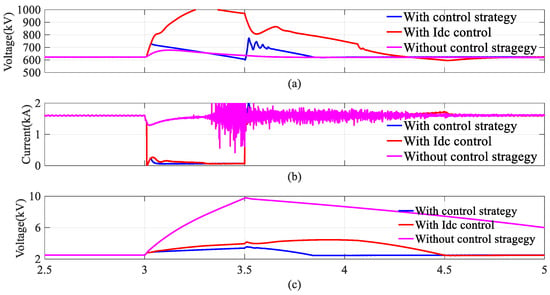
Figure 16.
The waveforms for the onshore converter. (a) The DC voltage of HVDC link; (b) The DC current of HVDC link; (c) Average capacitor voltage of onshore MMC.
If the onshore converter reduces the DC current in the HVDC link, the active power transmission of wind turbines to the onshore converter can be suppressed, as shown by the red curves in Figure 16 and Figure 17. However, the active power accumulates in the previous stage converter, namely the MMC-HVDR, causing the submodule capacitor voltage in the MMC and Vout to rise correspondingly. Under the active voltage limiting characteristic in the DR, the active power of the wind turbine begins to decrease slowly. However, energy still accumulates in the submodule capacitors of the MMC-HVDR during this period, causing the submodule capacitor voltage to continue to rise.
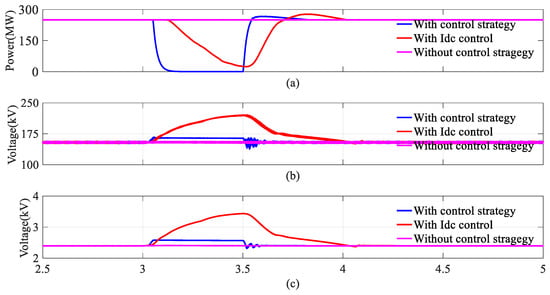
Figure 17.
The waveforms for the wind turbines and MMC-HVDR. (a) Active power of wind turbine; (b) Output voltage of MVDR; (c) Average capacitor voltage of MMC.
Once the overvoltage of the capacitor is detected, the active voltage rapid injection method proposed in this article will operate immediately, and force the intermediate variable AC voltage in the grid-side converter to be lower than the DC voltage. The active power transmission path is blocked quickly. This reduces the accumulation of active power in each stage and reduces the overvoltage, as shown by the blue curve in Figure 16c. Under the control strategy proposed in this article, the system achieved onshore AC fault ride-through.
5. Conclusions
Considering the unidirectional flow of wind power transmission, a topology based on a distributed parallel–series DR and its control strategy is proposed.
- (1)
- The coordinate control strategy is proposed to solve the energy curtailment, where the voltage control strategy for the parallel part and a current control strategy are for the series part according to the coupling mechanism of constant DC voltage and constant DC current.
- (2)
- A triple target control strategy based on the MMC-HVDR is proposed with an intermediate variable according to the characteristics of the DR, which maintains the capacitor voltage, input DC voltage, and output voltage simultaneously.
- (3)
- Energy accumulating during onshore faults is analyzed, and an active voltage injection control strategy is proposed for the ride-through of onshore faults without communication.
The simulation results verified the effectiveness of the system and its control strategies. Under the proposed control strategy, stable operation will not be affected by different kinds of disturbances. The wind turbine automatically operates at the MPPT without overvoltage. The system can achieve onshore fault ride-through quickly without a braking resistor.
The characteristics and control strategies for transient conditions such as asymmetric grounding faults and frequency drops in the onshore grid will be analyzed in the future. The hardware in the loop simulation platform will be built to verify the topology and control strategy.
Author Contributions
L.X.: Writing—original draft, Conceptualization, Formal analysis, Methodology, Software, Writing—review and editing. R.H.: Supervision, Writing—review and editing. Z.L.: Supervision, review and editing. B.L.: Writing—review and editing. Y.W.: Writing—review and editing. All authors have read and agreed to the published version of the manuscript.
Funding
This research was funded by the State Grid Corporation, grant number 5500-202358504A-3-2-ZN.
Institutional Review Board Statement
Not applicable.
Informed Consent Statement
Not applicable.
Data Availability Statement
The datasets used and/or analyzed during the current study are available from the first author upon reasonable request. (First author E-mail address: liju-xie@163.com).
Acknowledgments
Hao Ruixiang and Guoliang Zhao supervised this paper well. We thank Fan Cheng and Jing Wu for their timely help in reviewing. Surpport from the State Key Laboratory of Advanced Power Transmission Technology is gratefully acknowledged.
Conflicts of Interest
Author Lijun Xie, Ruixiang Hao were employed by Beijing Jiaotong University, and Author Lijun Xie, Zhengang Lu, Bao Liu and Yingpei Wang were employed by the company China Electric Power Research Institute. The authors declare that the re-search was con-ducted in the absence of any commercial or financial relationships that could be construed as a potential conflict of interest.
References
- Xu, L.; Liu, C.; Zhang, J.; Tian, Z.; Feng, P.; Huang, M. Characteristics Evaluation and Coordinated Control Strategy of Power-Electronics-Based MMC-HVDC Systems Connected with Wind Farms. Appl. Sci. 2025, 15, 2582. [Google Scholar] [CrossRef]
- El Myasse, I.; Mansouri, A.; El Magri, A.; Watil, A.; Kissaoui, M.; Lajouad, R. Robust Nonlinear Control Design of MMC-HVDC Systems for Wind Power Plants Integration. In Proceedings of the 2023 3rd International Conference on Innovative Research in Applied Science, Engineering and Technology (IRASET), Mohammedia, Morocco, 18–19 May 2023; pp. 1–5. [Google Scholar]
- El Myasse, I.; El Magri, A.; Watil, A.; Mansouri, A.; Kissaoui, M.; Ouabi, H.; Blouh, F.E. Enhancing Wind Power Plant Integration Using a T-NPC Converter with DR-HVDC Transmission Systems. IFAC-PapersOnLine 2024, 58, 472–477. [Google Scholar] [CrossRef]
- Blasco-Gimenez, R.; Ano-Villalba, S.; Rodríguez-D’Derlée, J.; Morant, F.; Bernal-Perez, S. Distributed voltage and frequency control of offshore wind farms connected with a diode-based HVDC link. IEEE Trans. Power Electron. 2010, 25, 3095–3105. [Google Scholar] [CrossRef]
- Bernal-Perez, S.; Ano-Villalba, S.; Blasco-Gimenez, R.; Rodriguez-D’Derlee, J. Efficiency and fault ride-through performance of a diode-rectifier-and VSC-inverter-based HVDC link for offshore wind farms. IEEE Trans. Ind. Electron. 2012, 60, 2401–2409. [Google Scholar] [CrossRef]
- Prignitz, C.; Eckel, H.G.; Achenbach, S.; Augsburger, F.; Schön, A. FixReF: A control strategy for offshore wind farms with different wind turbine types and diode rectifier HVDC transmission. In Proceedings of the 2016 IEEE 7th International Symposium on Power Electronics for Distributed Generation Systems (PEDG), Vancouver, BC, Canada, 27–30 June 2016. [Google Scholar]
- Herrera, D.; Galván, E.; Carrasco, J.M. Method for controlling voltage and frequency of the local offshore grid responsible for connecting large offshore commercial wind turbines with the rectifier diode-based HVDC-link applied to an external controller. IET Electr. Power Appl. 2017, 11, 1509–1516. [Google Scholar] [CrossRef]
- Yu, L.; Li, R.; Xu, L. Distributed PLL-based control of offshore wind turbines connected with diode-rectifier-based HVDC systems. IEEE Trans. Power Deliv. 2018, 33, 1328–1336. [Google Scholar] [CrossRef]
- Cardiel-Álvarez, M.Á.; Arnaltes, S.; Rodriguez-Amenedo, J.L.; Nami, A. Decentralized Control of Offshore Wind Farms Connected to Diode-Based HVdc Links. IEEE Trans. Energy Convers. 2018, 33, 1233–1241. [Google Scholar] [CrossRef]
- Yang, M.; Cai, X.; Wusiman, A.; Zhang, J.; Lyu, J. Distributed-Diode-Rectifiers-Based Offshore Wind Power MVDC Direct-Transmission System. IEEE Trans. Energy Convers. 2022, 37, 643–653. [Google Scholar] [CrossRef]
- Teng, B.; Ma, J.; Zhu, M. Diode-Rectifier-Based Offshore Platform for Wind Power Collection and HVDC Transmission System: Implementation and Hierarchical Control. IEEE Trans. Sustain. Energy 2025, 16, 812–825. [Google Scholar] [CrossRef]
- Zhu, Y.; Li, Y.; Li, B.; Li, T.; Xu, L.; Liu, N. Internal Energy Distribution Control Based Fault Ride-Through and Postfault Recovery Strategy for Offshore Wind Farms Connected to DR-MMC HVDC Under Onshore AC Grid Faults. IEEE Trans. Sustain. Energy 2025, 16, 1191–1205. [Google Scholar] [CrossRef]
- Xie, L.; Cheng, F.; Wu, J. Control Strategy for Offshore Wind Farms with DC Collection System Based on Series-Connected Diode Rectifier. Sustainability 2022, 14, 7860. [Google Scholar] [CrossRef]
- Li, L.; Li, B.; Wang, Z.; Yang, M.; Xu, D. Monopolar Symmetrical DC-DC Converter for All DC Offshore Wind Farms. IEEE Trans. Power Electron. 2022, 37, 4275–4287. [Google Scholar] [CrossRef]
- Robinson, J.; Jovcic, D.; Joos, G. Analysis and Design of an Offshore Wind Farm Using an MV DC Grid. IEEE Trans. Power Deliv. 2010, 25, 2164–2173. [Google Scholar] [CrossRef]
- Juan-David, P.; David, F.; Jose, M. Overview of DC-DC Converters Dedicated to HVDC Grids. IEEE Trans. Power Deliv. 2019, 34, 119–128. [Google Scholar]
- Alhurayyis, I.; Elkhateb, A.; Morrow, D.J. Isolated and Non-Isolated DC-to-DC Converters for Medium Voltage DC Networks: A Review. Inst. Electr. Electron. Eng. 2021, 9, 7486–7500. [Google Scholar]
- Liu, H.; Dahidah, M.S.A.; Yu, J.; Naayagi, R.T.; Armstrong, M. Design and Control of Unidirectional DC-DC Modular Multilevel Converter for Offshore DC Collection Point Theoretical Analysis and Experimental Validation. IEEE Trans. Power Electron. 2019, 34, 5191–5208. [Google Scholar] [CrossRef]
- Ansari, M.S.; Shukla, A.; Bahirat, H.J. Analysis and Design of MMC-Based High-Power DC-DC Converter with Trapezoidal Modulation. IEEE Trans. Power Electron. 2023, 38, 7256–7270. [Google Scholar] [CrossRef]
- Ye, Y.; Zhang, X.; Gao, C.; Wang, X.; Wang, Y.; Yang, X. Analysis and Comparison of Isolated High-Gain High-Voltage DC/DC Converters for Offshore Wind Farm Collection and Integration. IEEE Trans. Power Electron. 2024, 39, 8757–8769. [Google Scholar] [CrossRef]
- Zhao, P.; Meng, Y.; Ge, M.; Duan, Z.; Wang, X.; Wang, J. Series-Parallel Multiple Integrated Modular Multilevel DC-DC Converter for All-DC Offshore Wind Power System. IEEE Trans. Power Deliv. 2024, 39, 2482–2494. [Google Scholar] [CrossRef]
- Li, B.; Liu, J.; Wang, Z.; Zhang, S.; Xu, D. Modular High-Power DC-DC Converter for MVDC Renewable Energy Collection Systems. IEEE Trans. Ind. Electron. 2021, 68, 5875–5886. [Google Scholar] [CrossRef]
- Yang, W.; Song, Q.; Liu, W. Decoupled Control of Modular Multilevel Converter Based on Intermediate Controllable Voltages. IEEE Trans. Ind. Electron. 2016, 63, 4695–4706. [Google Scholar] [CrossRef]
Disclaimer/Publisher’s Note: The statements, opinions and data contained in all publications are solely those of the individual author(s) and contributor(s) and not of MDPI and/or the editor(s). MDPI and/or the editor(s) disclaim responsibility for any injury to people or property resulting from any ideas, methods, instructions or products referred to in the content. |
© 2025 by the authors. Licensee MDPI, Basel, Switzerland. This article is an open access article distributed under the terms and conditions of the Creative Commons Attribution (CC BY) license (https://creativecommons.org/licenses/by/4.0/).